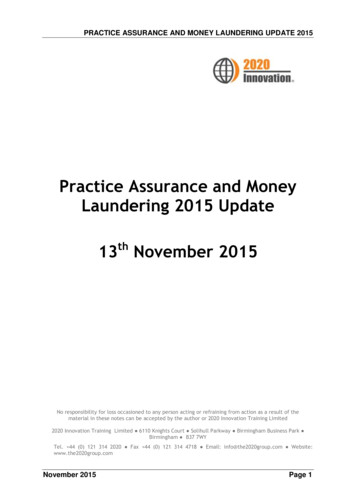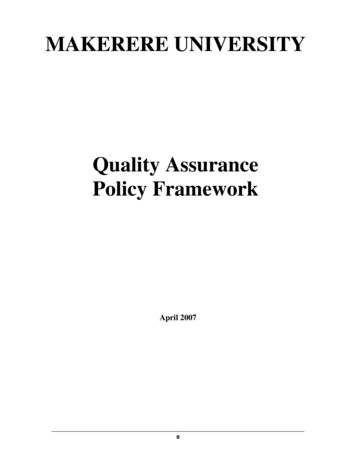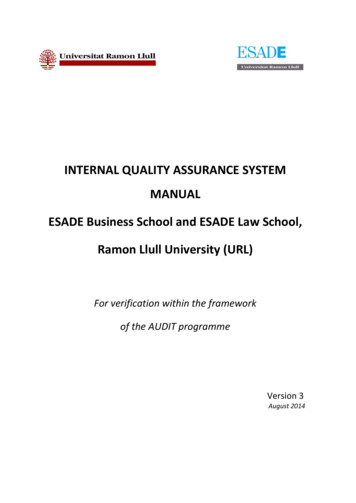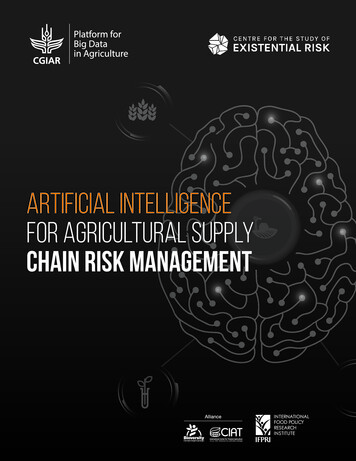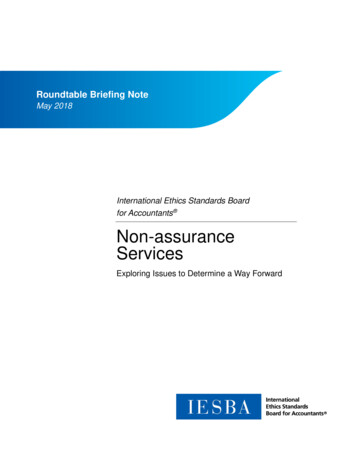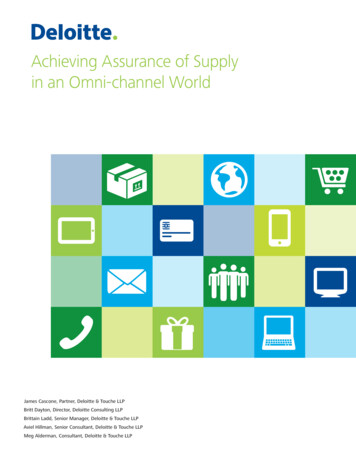
Transcription
Achieving Assurance of Supplyin an Omni-channel WorldJames Cascone, Partner, Deloitte & Touche LLPBritt Dayton, Director, Deloitte Consulting LLPBrittain Ladd, Senior Manager, Deloitte & Touche LLPAviel Hillman, Senior Consultant, Deloitte & Touche LLPMeg Alderman, Consultant, Deloitte & Touche LLP
Table of contentsOmni-channel challenges and opportunities2Omni-channel supply chain challenges3Setting the strategy: Omni-channel as a growth enabler4Strategic supply chain risk considerations5Developing a supply chain risk management program6The inventory challenge10
IntroductionIn Greek mythology, Sisyphus was a King punished by being compelled to roll an immense boulder up a hill, onlyto watch it roll back down just as he was about to reach the top of the hill, and to repeat this action forever. Manysupply chain executives can empathize with Sisyphus as they face challenges day in and day out to balance supplywith demand. Due to stock-keeping unit (SKU) proliferation, the increased pace of innovation, changing consumerpreferences, and unforeseen supply disruptions, their best efforts may still result in backorders, excessive inventory,strained third-party relations, loss of consumer confidence in the brand, and perhaps reduced sales and shareholdervalue. Technology has placed information and increased buying power into the hands of consumers who seeka consistent, seamless experience through all available channels (“omni-channel”). Companies are now facingunforeseen strategic risks from an increasingly complex global supply chain network that may not be optimized foran omni-channel world.Achieving Assurance of Supply in an Omni-channel World1
Omni-channel challengesand opportunitiesOmni-channel is defined herein as a direct to consumer (D2C) business model where all sales channels ranging fromonline, mobile, telephonic, mail order, self-service, and physical retail establishments are aligned and fulfillment processesintegrated to provide consumers with a seamless shopping experience in alignment with the company’s brand proposition.The underlying benefit to retailers (including restaurant, foodservice, hardline and softline merchants) is the opportunity touse multiple channels to market their products and increase sales by accessing customers across all segments and levels oftechnological sophistication who place orders via their preferred channel(s) on a 24x7 basis.However, the multitude of channels greatly increases the importance of supply chain management, particularly the abilityto assure supply and manage supply chain risks to decrease disruptions. In essence, omni-channel increases demandplanning complexity due to difficulties in obtaining real-time demand signals across all channels, synchronizing thecaptured data to account for timing differences, and holistically analyze impacts on sourcing, procurement and operationsplanning. Balancing supply and demand real-time across all available channels in a world where consumers expectrapid fulfillment and delivery, including the increased desire for same-day delivery within a specified hourly window is asignificant challenge. Omni-channel retailing also increases the complexity of managing inventory and assuring supplyin an environment where some or all aspects of the supply chain are outsourced and operational requirements spanmultiple global geographies. Retailers that operate in an omni-channel environment without an optimized inventory anddistribution capability may encounter such risks as stock outs, expedited freight charges to reposition inventory, andreduced profits which impacts their objective of assuring sales are at the highest possible margin.A robust supply chain risk management program that addresses the strategic risks impacting the ability to provide aseamless consumer experience should be the cornerstone of any omni-channel strategy if consumer businesses (defined asD2C retail, consumer product, hospitality and foodservice providers) want to reduce disruptions, enhance enterprise value,grow revenues, protect brand reputation, and provide a heightened customer experience.This white paper provides an overview of strategies that can be considered when developing a supply chain riskmanagement program that improves assurance of supply, reduces the complexity associated with seamless inventorymanagement, and enhances omni-channel supply chain resiliency.2
Omni-channel supplychain challengesEffective omni-channel strategies commonly align supply with demand to satisfy customers and create a consumerexperience that is consistent with overall brand proposition in an ever interconnected world of e-commerce enabledthrough multiple technology platforms and interfaces. Technology, from Smartphones and apps that allow on-the-goshopping, to the use of social networking to create demand, is revolutionizing retail and driving the increased pushinto omni-channel. While there is high-quality opportunity to increase brand awareness, Omni-Channel retail can alsoexacerbate the basic struggle to maintain high customer satisfaction. As the number of channels increase, retailers mayattract new customers. Gaining visibility into this new customer base, predicting demand generated through each channel,and designing your supply chain network for flexible fulfillment are key elements to meeting customer expectations andmaximizing use of resources.Consumer businesses should have clear visibility to all inventory levels for all supported sales channels to confirm thatthey can facilitate delivery to the customer of any particular item, color and size, when and where desired. This meansrelations with suppliers are quickly migrating from low-cost supplier selection to strategic, collaborative, assurance ofsupply agreements. In addition, there also needs to be a proactive approach to identifying and assessing risks at variouspoints in the supply chain in the light of demand variability, limited visibility to tier 2 suppliers, global logistics operationsand an interconnected network of suppliers. Demand sensors, predictive risk analytics, supplier verification programs, andlogistics control towers are key measures organizations are employing to reduce supply/demand variability and the impactof disruptions; thereby improving assurance of supply.Achieving Assurance of Supply in an Omni-channel World3
Setting the strategy: Omnichannel as a growth enablerContrary to what some may assume is a critical first stepfor embarking on an omni-channel path, it is not to makeinvestments in technology. Rather, it is in setting the omnichannel strategy, evaluating strategic risks to the strategy,and appropriately aligning supply chain objectives andcapabilities to the strategy. Omni-channel strategies varybased on a company’s aspirations and capabilities, andmerit a separate discussion. Outlined below at a high-levelare some considerations when determining an omnichannel strategy that will impact supply chain: Holistic approach to pricing and trade promotions acrossall channels:–– Customers may become frustrated and lose trust inthe brand when the same item is priced differentlyon-line vs. in the store, unless the strategy calls forin-store promotions to increase traffic. Providingtransparency is key to maintaining trust.–– Scenario planning and modeling can be utilized toidentify how to reduce supply chain network costsacross channels, which will aid in price-setting. Listen to the voice of the customer. What motivates yourcustomer to buy from you?–– Your omni-channel strategy should reflect how yourcustomer wants to buy. not how your company isorganized. If the company isn’t currently structuredto capitalize on the synergies of omni-channel,organizational change should be considered toimprove alignment. Consider flexible fulfillment processes with technology asan enabler.–– Inventory optimization technology can providereal-time visibility into the locations of all productsacross all channels enabling flexible fulfillment.–– Providing a single view of available inventoryimproves inventory management, capacity planning,and maximizes sales potential. Internal collaboration is a key success factor.Representatives from sales, marketing, technology,merchandising, finance, supply chain (sourcing, logistics,etc.), and operations should collaborate to answer thefollowing questions:–– What is our winning aspiration?–– Where will we focus?–– What capabilities need to be in place?–– What are possible scenarios and what disruptorsmay we face?A successful omni-channel supply chain strategy shouldfocus on constructing a business model that addressescustomers’ needs, and leverages the power of analytics tomonitor supply chain performance and continually sensedemand signals across channels.4
Strategic supply chain riskconsiderationsThe topic of risk may sometimes be overlooked bycorporations when discussing omni-channel retailing.Refining supply chain operations to keep pace with everchanging customer demands and omni-channel trendsrequires constant vigilance. Such environments inherentlyintroduce additional, and potentially unforeseen, supplychain risks than in traditional models.Supply chain objectives can typically be characterizedas follows:Assessing gaps in supply chain capability to supportthe omni-channel strategy can provide directionfor investments in talent, technology, and processimprovement needed to achieve the supply chainobjectives. The following questions can be utilized as aguide when evaluating your omni-channel supply chain:1. Is your supply chain IT infrastructure and applicationcapability sufficiently flexible to support multiplechannels and unpredictable fluctuations intransactional volume?2. Do you have the right collaborative supplierrelationships in place to provide the scalability requiredto assure supply in an omni-channel environment?3. Do you have sufficient visibility into Tier N suppliercapacity and current baseline performance in meetingcustomer demand within your supply chain network?Are additional investments in facilities required or willa flexible fulfillment design provide a moreoptimal solution?4. Have you conducted supply chain network, inventory,and transportation optimization to identify the optimalsupply chain for meeting customer demand acrossall channels?5. Do you have well-designed reverse logistics programs inplace capable of managing returns regardless ofthe channel?6. Do you have complete visibility across the supply chain?7. Have you conducted SKU analytics to evaluate theimpact of increased SKU count on warehousing,distribution, and fulfillment?8. Do you have a robust Assurance of Supply strategy inplace that minimizes potential risk while maximizingprofit potential through SKU availability?Although not a comprehensive listing, the questions listedabove are essential in terms of gaining an understandingof ‘As-Is’ vulnerabilities within your organization and acrossthe value chain. Optimization, analytics, and a supply chainrisk management program can provide the foundation forclosing the gaps in the future state of your omni-channelsupply chain and provide continuity of supply.Figure 1: Deloitte’s Supply Chain Objectives FrameworkSupply Chain ObjectivesProduct/Service DeliveryProduct/ServiceInnovationCost and Return onAssets ManagementRegulatory/Safety/Social ComplianceAs used in this document, “Deloitte” means Deloitte & Touche LLP and Deloitte Consulting LLP, which are separate subsidiaries of Deloitte LLP. Please see www.deloitte.com/us/about for adetailed description of the legal structure of Deloitte LLP and its subsidiaries. Certain services may not be available to attest clients under the rules and regulations of public accounting.Achieving Assurance of Supply in an Omni-channel World5
Developing a supply chain riskmanagement programIn order to be effective in an omni-channel world, eachchannel should be profitable and be able to meet customerdemand. However, certain channels may be enteredinto to attract new customer segments (e.g., Gen-Y) orimprove the overall customer experience, even if at a loss.Increased competitive pressure from pure online retailersare pressuring traditional brick and mortar consumerbusinesses to implement strategies that maintain marketshare at the expense of operational cost increases.Regardless of the reasons, customer satisfaction andincreased sales remain key priorities, which can only beachieved through a properly designed supply chain thatmitigates disruption risks and allows the sufficient flow ofsupply to meet demand.As a result, leading companies are developing businessmodels that focus on maximizing customer satisfaction byachieving an optimal balance between performance (e.g.,accurate fulfillment), cost (e.g., minimizing transportationexpense), and risk (e.g., providing safe, unadulteratedproducts). Companies may source from new or untriedsuppliers as a stopgap measure when facing supplyshortages, and may inadvertently expedite products ofinferior quality; thereby, increasing the risk of productreturns even though cost and service objectives may havebeen met. Brand reputation risks, recall costs, and anyadditional regulatory scrutiny would likely outweigh anybenefits derived from the product sales.Assuring the supply of goods entails far more thanproviding the correct products at the right time via therequested channel at the desired margins. Identifying,assessing and managing strategic risks that can disruptyour supply chain and erode consumer (not just customer)trust in your brand are critical components of an omnichannel strategy.Developing a supply chain risk management program thatincorporates the use of supply chain network optimizationand risk quantification techniques will assist in designingan optimal omni-channel supply chain that balances cost,performance and risk. Figure 2 below presents a visualdisplay of results from a supply chain network optimizationmodeling engagement for a company expanding theiroperations in China.The purpose of the modeling was to identify the lowestcost and lowest risk logistics network to meet customerdemand taking into account projected sales increases overFigure 2: Deloitte Supply Chain Risk Modeling leveraging LLamasoft, Inc. technology6
a five-year period. The graph pictorially presents wheredistribution centers should be located to meet demandacross all service level requirements, while minimizingtransportation costs from ports to distribution centers,distribution centers to stores, and direct-to-consumerusing a combination of dedicated fleet, common carriage,parcel, and third-party delivery carriers.Financial analysis was conducted to evaluate strategiesfor reducing duties, taxes, transportation costs, andworking capital requirements through optimal inventorymanagement. Sensitivity analysis was conducted toevaluate sourcing options that minimize the risk ofdisruptions and provide greater assurance of supply.Incorporating performance, cost, and risk impacts intoa comprehensive model allows companies to makeenhanced strategic decisions related to their omni-channelsupply chain requirements, as well as market entry and/orexpansion across developed or emerging markets.This balanced approach to managing the three pillars ofperformance (service), cost, and risk (e.g., global trade,product safety or environmental compliance/sustainability)in the supply chain can drive improved customersatisfaction. A supply chain risk management programshould include mitigation plans that help decrease theseverity of supply disruptions throughout the value chainand provide the analytical insights required to develop aflexible supply chain to support each channel. A supplychain network design that doesn’t take into considerationassurance of supply strategic risks will be consideredsub-optimal and can result in: Excessive safety stock resulting in potential obsolescence,additional carrying costs, and sub-optimal use ofworking capital Over-reliance on costly air-freight logistics due to lack offlexible demand fulfilment Supply disruptions of longer duration or severity Loss of sales (order cancellations) or increased cost ofsales (expediting orders) Damage to brand reputation resulting from unsatisfiedcustomers.The ability to manage performance, cost and risk isbecoming ever more complex as omni-channel businessesstrive to meet the expectations of the modern consumer.The evolution of omni-channel shopping is having asignificant impact on how supply chains are designed,driving a greater need to understand cost-to-serve andprotect margin erosion as channels and SKUs increase.Demand fluctuations during seasonal peak or promotionalperiods are particularly challenging and taxing on supplychains, requiring networks to be designed with greaterflexibility and control. It is our view that consumerbusinesses should place increased focus on transformingsupply chain networks to align with their omni-channelstrategy.Channel variety increases consumption and successawaits omni-channel businesses that can providevariety and meet demand.The harsh reality is that omni-channel is rapidly movingaway from something to be considered, to being amust-have for surviving and thriving. The recommendedapproach is to embrace the new reality of omni-channelwhile also investing in more in-depth analysis on consumerdemand, and aligning supply chain objectives withcorporate strategy to create a competitive advantage.Failure to build a resilient supply chain acrosschannels is a significant strategic risk that can impactenterprise value. Inefficient use of resources or capital applied towardsone channel over anotherAchieving Assurance of Supply in an Omni-channel World7
Several risk events can impact the end-to-end supply chain across nodes, such as those listed in Figure 3, and can prevent companies from meeting theirsupply chain objectives:Figure 3: Deloitte’s Supply Chain Risk Framework - Disruptors8Product Flow - SupplyCapacity of upstream node(s) (i.e., suppliers, ports, 3rd Party Logistics (3PLs)), or routes linking nodes, is materially reduced for a significant periodof time resulting in higher costs (e.g., expedited transportation, higher cost alternate source) and/or lost salesProduct Flow ProductionCapacity of owned or contract manufacturing facility, or route linking upstream and downstream manufacturing facilities, is materially reduced fora significant period of time resulting in higher costs (e.g., expedited transportation) and/or lost salesProduct Flow DeliveryCapacity of downstream node(s) (i.e., distribution facilities, ports, 3PLs), or routes linking nodes, is materially reduced for a significant period oftime resulting in higher costs (e.g., expedited transportation) and/or lost salesDemand - SpikeGrowth rate of demand for a product exceeds capability to ramp up production or exceeds total capacity causing a shortage of product availablein the market resulting in lost salesDemand - CollapseRate of decline of demand for a product exceeds capability to ramp down production or necessitates line/facility shutdown resulting in lower salesand excess inventoryMargin Erosion - CostRapid inflation of input prices (costs) cannot be offset with sales price increases or productivity improvements resulting in lower gross and/ornet marginsMargin Erosion - PriceCapacity of upstream node(s) (i.e., suppliers, ports, 3PLs), or routes linking nodes, is materially reduced for significant period of time resulting inhigher costs (e.g., expedited transportation, higher cost alternate source) and/or lost salesRegulatoryNon-ComplianceFailure to comply with laws and regulations of one or more jurisdictions resulting in financial liabilities (fines, etc.) or closure of one or morefacilities (see Product Flow disruptions above)Social Resp.FailureFailure to meet societal expectations due to business practices or structure resulting in sustained damage to brand reputationQuality FailureFailure of product quality causes poor or unsafe customer experience resulting in product recalls, warranty claims and/or lower sales
A supply chain risk management program will include adiscovery process that assesses the likelihood, velocity(speed of onset) and severity of these disruptions on youromni-channel supply chain and appropriate mitigationstrategies. Once “unknown known” disruption risks aremore easily understood and a risk response strategydeveloped, the organization can develop a supply chainrisk management program that enhances supply chainresiliency and improves assurance of supply. Resilientsupply chains address critical vulnerabilities and improvethe organization’s ability to design greater visibility,flexibility, collaboration, and control in their supply chain.Achieving Assurance of Supply in an Omni-channel World9
The inventory challengeAchieving assurance of supply in omni-channel requiresthe ability of consumer businesses to master their supplychains, especially cross-channel inventory management.Without effective cross-channel inventory management,assurance of supply is disrupted, which may lead to one ofseveral scenarios: Orders go unfulfilled leading to lost sales, customerdissatisfaction, and potential negative coverage acrosssocial media impacting brand reputation Suppliers reduce the amount of product allocated ormanufactured due to lack of confidence in sales plansand fear of financial losses (e.g., inventory obsolescence) Channels within the organization may operate in silosand hold inventory for fear of not meeting customerdemand within their channel Increased risk of losing market share to companies thatcan efficiently meet demand.As more channels are added, accurate sales forecastingand inventory management become more challenging,particularly if a company’s products are seasonal or if thereis suboptimal internal coordination with marketing andinnovation on limited time offers and promotions. Demandplanning for example, becomes especially complex due tothe need to capture and analyze dynamic demand signalsacross multiple channels, suppliers, and nodes. Flexiblefulfillment is an improved method of maximizing inventoryutilization within the network to meet customer demandand complete sales. Flexible fulfillment strategies can addcost to the business; therefore it’s critical to incorporatelearnings from flexible fulfillment back into the demandforecasts to improve inventory planning.If an omni-channel retailer gets cross-channelinventory management wrong, supply chain andfinancial performance will be negatively impacted.A key requirement for effective cross-channel inventorymanagement and assurance of supply is confirming thatthe required physical supply chain assets are available tomeet customer demand. Prior to omni-channel, manycompanies placed their focus on building large distributioncenters (DC) whereby suppliers shipped directly to each10DC within a customer’s network. In a single-channelDC to store environment, investing in large DCs was aviable strategy as retailers could consistently replenishstore shelves with scheduled deliveries. However, aschannels increase and customers are seeking immediategratification from their purchases, such as crowd-sourceddelivery services that offer the promise of nearly limitlessflexible scheduling and delivering, more time-sensitiveoptions are required above and beyond traditional DCto store (or consumer) logistics. Crowd-sourced deliveryservices introduce new risks to the business, and canelevate both reputational risk and financial liability riskin the event of a mishap. This is an emerging businessmodel, not dissimilar to subcontracting, that is onlynow beginning to raise awareness around potential risksthat on-demand flexibility provides. Ordering on-lineand fulfilling in store is also becoming a commonplacebusiness practice to accommodate the customer need forconvenience. However, this requires accurate real-timecross-channel inventory data and places a burden onstore employees to fulfill online orders slated for customerpick-up. Customer satisfaction in the store may also sufferat the expense of online customers unless dedicated storeemployees are designated to fulfill online orders.Consumer businesses and suppliers may lack the internalresources required to assess strategic risks, conductsupply chain risk modeling, and optimize their networkto improve assurance of supply as outlined in this whitepaper. Establishing a supply chain omni-channel strategythat doesn’t address the strategic risks impactingassurance of supply may put executives in a situation notdissimilar to Sisyphus’, struggling to push a boulder up ahill. Leveraging external expertise to assist organizationswith taking proactive, strategic measures to managesupply chain disruptions and improve assurance of supplycan bring significant value. Sisyphus was a mythologicalfigure, but the challenges associated with omni-channelstrategies and the opportunities that can be realized frombuilding resilient supply chains to assure supply are real.
Achieving Assurance of Supply in an Omni-channel World11
ConclusionFive short years ago, few consumer businesses had heard of the term ‘omni-channel’ and fewer companies everbelieved they would be confronting the type of consumer revolution and empowerment that is now taking place.The risks associated with ignoring the exploding reach and requirements of omni-channel strategies cannot be ignored.Strategic alignment with supply chain objectives, designing supply chain risk management programs that enhanceresiliency, and utilizing advanced analytics to provide greater insights and control are key elements for successfullyachieving assurance of supply in an omni-channel world.About Deloitte’s Supply Chain Risk Advisory PracticeWe help clients transform how they manage supply chain risks by designing supply chain risk management programs,enhancing global supply chain compliance capability, and delivering solutions to improve assurance of supply. Deloittealso provides consulting services related to supply chain strategy & operations, sourcing & procurement, logistics &distribution, and sustainability in over 120 countries around the globe through the Deloitte Touche Tohmatsu Limitednetwork of member firms.Figure 4: Deloitte’s Supply Chain Ranking by Kennedy Consulting and ResearchDeloitte Ranked #1 inSupply Chain by KennedyConsulting and ResearchAdvisory“Of the multi-service firms that deliver supplychain risk consulting services through supply chain,operations, and risk practices, the firm Deloitteachieves the greatest combination of breadth anddepth.”“Deloitte has some of the strongest SCM capabilitiesin the marketplace. The SCM practice has both broadand deep functional capabilities Clients appreciateDeloitte’s hands-on, results-oriented approach.”“In addition to its Deloitte’s leading risk practices,Deloitte’s supply chain and operations practices arenot only the largest in the industry, but also can toutdeep technical knowledge including, for example,food science and engineering experts.”Source: Kennedy Consulting Research & Advisory; Supply Chain Risk Management Consulting,2012 – 2015 Report; 2012 Kennedy Information, LLC. Reproduced under license12
This document contains general information only and Deloitte is not, by means of this document, rendering accounting, business, financial,investment, legal, tax, or other professional advice or services. This document is not a substitute for such professional advice or services, norshould it be used as a basis for any decision or action that may affect your business. Before making any decision or taking any action thatmay affect your business, you should consult a qualified professional advisor. Deloitte shall not be responsible for any loss sustained by anyperson who relies on this document.Copyright 2015 Deloitte Development LLC. All rights reserved.Member of Deloitte Touche Tohmatsu Limited
the value chain. Optimization, analytics, and a supply chain risk management program can provide the foundation for closing the gaps in the future state of your omni-channel supply chain and provide continuity of supply. Supply Chain Objectives Product/Service Delivery Product/Service Innovation Cost and Return on Assets Management Regulatory .
